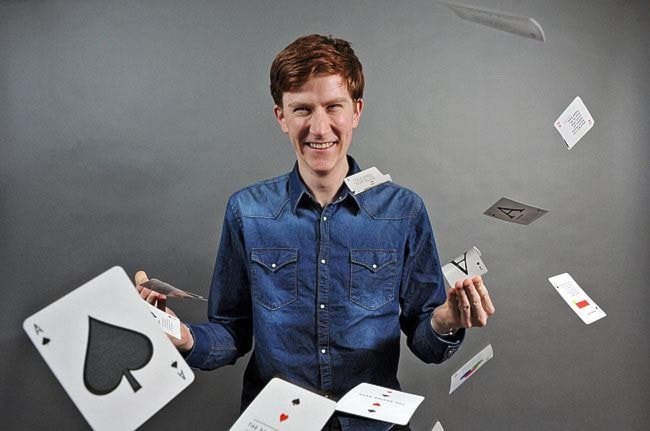In Ben Barrett-Forrest’s world, design is everywhere.
It’s in the shape of the pen your barista uses to jot down your morning coffee order. It’s in the colour of the Zero Waste coffee cup sleeve when she hands it to you, and it’s in the font on the posters that grab your eyes - or don’t - as you leave the coffee shop on the way to the office.
Design, either good or bad, influences our world in subtle yet sometimes profound ways. And now, thanks to Barrett-Forrest’s latest brainchild, you can hold all the tools of design in the palm of your hand - or up your sleeve, for that matter.
Barrett-Forrest’s graphic design chops made headlines across North America last year when he published his History of Typeface video on YouTube. The stop-motion-animated short explains in laymen’s terms the history of font and printing.
It was a huge hit and went viral almost immediately, racking up almost 800,000 views. As interest in the video rose, it got picked up by outlets like The Atlantic Magazine’s website and Internet design heavyweight Co.Design.
Now the Whitehorse design genius is back, this time with a project that isn’t just made up of bytes and audio clips.
The Design Deck is a pack of 52 playing cards, each with a tidbit of design history, a useful tip to remember or a witty inspirational quote. The project started as his final school project, but has since grown into its own small business.
“It started off as a thesis project. I just graduated from my undergrad at McMaster University in multimedia. I wanted to do something that might actually be useful for the world,” he said.
So, why playing cards?
“Playing cards are big right now. There’s kind of a renaissance of playing cards. On any design website or any Pinterest design feed, there are tons of playing cards,” Barrett-Forrest said.
“I think that’s because there’s just so much potential for design in them. Each of the cards is its own little design face, plus there’s the packaging of the pack itself,” he said.
Barrett-Forrest said he made the deck as a sort of pocket textbook for graphic design. It’s similar to musician Brian Eno’s well-known card deck Oblique Strategies, which offers suggestions for artists trying to break through blocks in the creative process.
“I figured if I was going to be putting in all this work, I thought I would see if anyone out there would actually want the deck, so I put it up on Kickstarter,” he said.
He set a target for the crowdfunding project of $600 with a timeline of 30 days to reach that goal. A month later, he has now earned $27,200. The project broke its original goal within 20 hours.
“It’s amazing to witness virality,” he said.
After the initial excitement over the project, the pledges rolling in started to die down and there were days with no activity at all, Barrett-Forrest said.
Then, just days before the pledge period was set to end, design website Design Taxi picked it up and ran a short story about it.
After that, pledges exploded, Barrett-Forrest said.
The extra money has allowed Barrett-Forrest to print with a top of the line company: Bicycle Playing Cards, the Las Vegas standard.
“The catch is that you have to print at least 2,500 decks with them. That’s the baseline. Setting out, that was just a pipe dream, but now it’s actually happening,” he said.
He has sold 1,230 decks so far.
The other advantage of printing with Bicycle is that Barrett-Forrest now has a huge variety of inks and typefaces and colours to choose from, “everything from metallic inks, to nice embossing and gold foiling on the cases.”
With Kickstarter, once the pledging period is over, that’s it. No one can pledge any more, but if people want to buy the cards they can head over to Barrett-Forrest’s personal website at ForrestGoods.com.
The deck retails for $22, and already Barrett-Forrest has been getting orders from all over the world, including retailers that want to sell his cards.
As he sees it, design isn’t just about making pretty things. Creating something concrete that people can actually use is a great way to help spread messages and information, Barrett-Forrest said.
Design can even be used to make the world a better place.
“There is so much that could be improved in the way people read things, and even in the budgeting and environmental impact of printing, just by changing something as simple as typeface,” he said.
Recently a teenager in the U.S. made headlines with a school project that showed the U.S. government could save hundreds of millions of dollars a year just by switching to a new typeface.
“The government could save almost $234 million simply by switching to that one font. That’s because the font is thinner, it’s lighter, it just simply uses less ink,” Suvir Mirchandani told CNN.
“Yeah, and Garamond is a nicer looking typeface, too,” Barrett-Forrest said, laughing.
Now that he’s finished his undergrad, Barrett-Forrest is headed straight into a four-month gig as The Globe and Mail’s design editor, and then onwards to a stint at a design firm in Sweden.
Now armed with his Design Deck, he’s got an ace in the hole and a unique set of calling cards.
Contact Jesse Winter at
jessew@yukon-news.com
